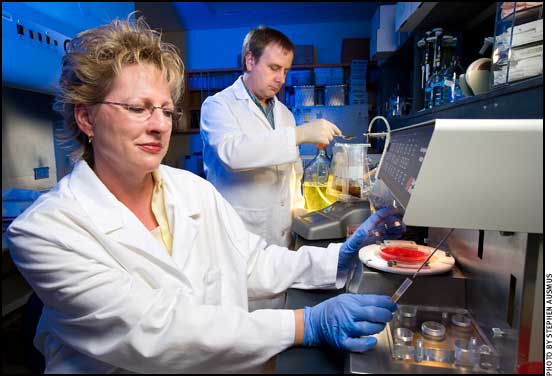
Microbiologist Jim Wells is investigating the relationship between WDGS-based feed and the incidence and persistence of E.coli O157:H7 in cattle manure and on their hides. Here, Wells processes bovine fecal samples for microbial analysis while microbiologist Elaine Berry plates the processed samples for E. coli tests.
WDGS & E. coli:
Is There a Connection?
Studies focus on feed ingredient's effects
on levels of E. coli O157:H7 in cattle.
After corn is processed to make ethanol, what's left of the corn looks something like slightly dampened cornmeal, though a somewhat darker yellow, and not as finely ground. Known as wet distillers' grains with solubles (WDGS), this byproduct is sometimes used as a cattle feed ingredient. U.S. Department of Agriculture (USDA) scientists in Clay Center, Neb., are studying the pros and cons of that practice.
WDGS are rich in protein, and also provide calories and minerals, according to James Wells, a microbiologist with USDA's Agricultural Research Service (ARS).
Since 2007, WDGS have been the subject of an array of studies by Wells and others at the ARS Roman L. Hruska U.S. Meat Animal Research Center (USMARC) in Clay Center. Wells has led studies to investigate the relation between use of WDGS in feed and the incidence and persistence of E. coli O157:H7 in cattle manure and on the animals' hides.
Cattle are a natural reservoir for the microbe. It is apparently harmless to them, but can cause illness in humans. E. coli in manure can newly infect or reinfect animals in pastures and feedlots; if E. coli ends up on the animals' hides, it could subsequently contaminate meat and equipment at the packinghouse.
In early experiments with 608 steers, Wells and his colleagues at Clay Center showed that the incidence and prevalence of E. coli O157:H7 in manure, and the incidence on hides, was significantly higher for cattle whose corn-based feed included 40% WDGS than those whose feed did not include WDGS.
Wells, along with research leader Tommy Wheeler, food technologist Steven Shackelford, microbiologists Elaine Berry and Norasak Kalchayanand, and other colleagues at Clay Center published some of these findings in a 2009 article in the Journal of Food Protection. The research was funded in part by the beef checkoff, a promotion and research program funded by U.S. beef producers and importers.
 In follow-up studies, the researches want to determine what causes the difference in E. coli levels, and what can be done to reduce them.
In follow-up studies, the researches want to determine what causes the difference in E. coli levels, and what can be done to reduce them.
[Click here to go to the top of the page.]










